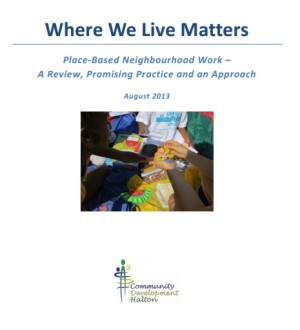What we’re reading: Where we live matters
 Title: Where We Live Matters | Place-based neighbourhood work – A review, promising practice and an approach
Title: Where We Live Matters | Place-based neighbourhood work – A review, promising practice and an approach
Authors: Jody Orr and staff of Community Development Halton
This new publication from Community Development Halton is a comprehensive read for any community development animator who works directly in neighbourhoods. Recognizing that the landscape of community work has changed dramatically in the past two decades, Orr and her associates urge us to adapt our approaches with the changing needs of our communities. And in case you’ve missed it, communities have changed!
This 70 page publication makes the case for ‘place-based neighbourhood work’ and details an engagement framework (pictured below) – An Approach to Building Neighbourhoods. Community work never follows a linear process and “Where We Live Matters” recognizes that neighbourhoods operate in a cyclical, repeated fashion between all stages of the engagement process depending on the issue or situation and the people involved in the work. It’s messy, chaotic and creative work and it’s hard to capture it accurately on paper!

What I like about the model (pictured above) is that they break down the engagement process into more manageable building blocks. I can’t recall ever seeing ‘readiness’ so prominently placed in an engagement process – we all know it’s necessary – so glad to see it named in plain language. I think the distinction between social capital and social capacity is important. Too often, they are used interchangeably, but they truly are distinct concepts in community building.
The remainder of the article outlines:
- the key characteristics of communities in which effective community building processes have been carried out,
- the personal and professional qualities and skills of the people involved in effective neighbourhood work
- best and promising practices in neighbourhood work, focusing on place-based activity
- a brief history of place-based neighbourhood work
When you read the brief history of place-based work (Appendix 1), it’s easy to see how far community work has strayed from the direct neighbourhood level. “Where We Live Matters” urges a shift from the universal, service delivery approaches of the past decades, revisiting the classic community development approach of place-based work. There’s no denying it; there are unique and pressing needs in specific geographic areas of every city, town and municipality. Try as we might, universal approaches will never reach the most vulnerable neighbourhoods in our communities. The work needs to be done where it matters most – in neighbourhoods where people live, and with people who live there.
There’s a subtext to this article that is hard to ignore. It speaks to the role of traditional service delivery institutions, large systems and government social policy. Essentially… these entities are too slow and inflexible enough to respond to the needs of neighbourhoods. Often, these systems and institutions are so policy bound that they actually become an obstacle for the communities they are designed to be helping. Which reminds me of so many stories from the very wise Jim Diers who claims that government and large agencies are often the greatest stumbling block for neighbourhoods and communities.
Isn’t that upside down?
As a community practitioner and animator myself, it’s always refreshing to come across good applied research and this one is solidly rooted in practice and the experience of people working effectively with neighourhoods. The authors draw on the work of pioneers of community work such as:
- Joh McKnight
- John Kretzman
- Bill Lee
- Margaret Wheatley
- Paul Mattessich, Barbara Monsey & Corinna Roy
“Where we live matters” is not new earth-shaking work, but resonates with my own community work as an animator and echoes the growing plethora of place-based initiatives such as:
- the Project for Public Spaces
- The Great Neighbourhood Book
- How to Design our World for Happiness
- Tamarack’s 1000 Conversations about Community
- Yes, In My Back Yard (YIMBY)
To better understand the document, check out this Tamarack podcast with Joey Edwardh, Jody Orr and Rishia Burke of Community Development Halton. They lead you through this resource document including an exploration of what inspired the investigation, the important role of an “animator” who enlivens and encourages development in community, funding for work that is hard to measure, and more!
After reading “Where we live matters” I wanted to go pull the McKnight, Kretzman, Lee and Wheatley books from the bookshelf and get reacquainted with the foundations of place-based work. There’s inspiration to be found for our daily work.
But most importantly, “Where we live matters” reminds us that what goes on in our neighbourhoods and the quality of life there has the greatest impact on our quality of daily living. We absolutely should be investing in neighbourhoods.
